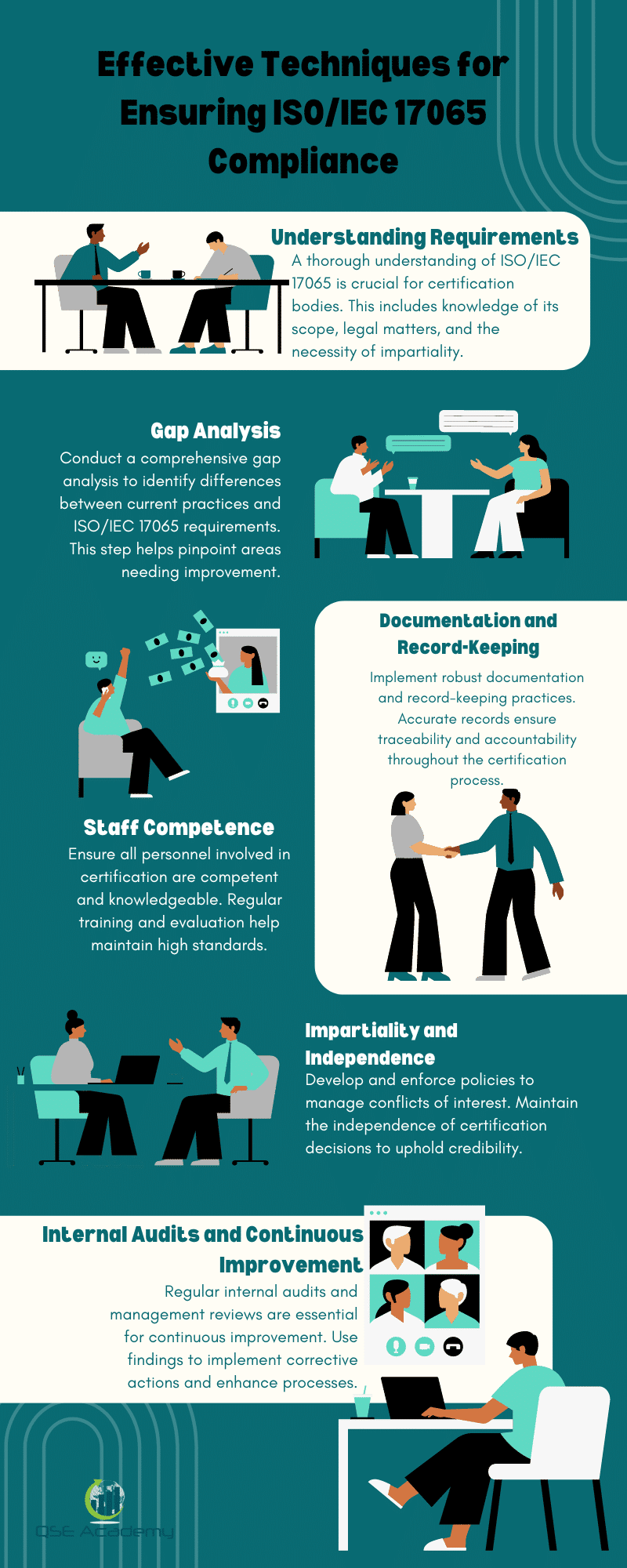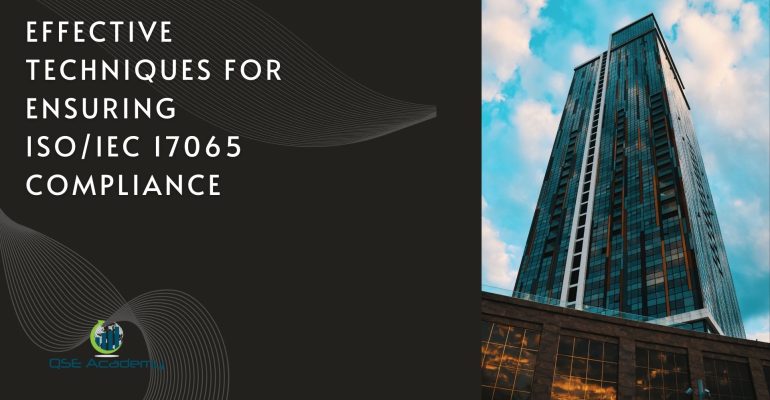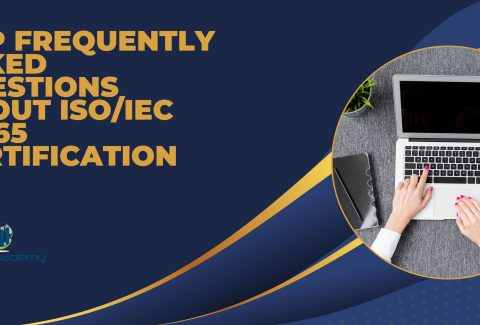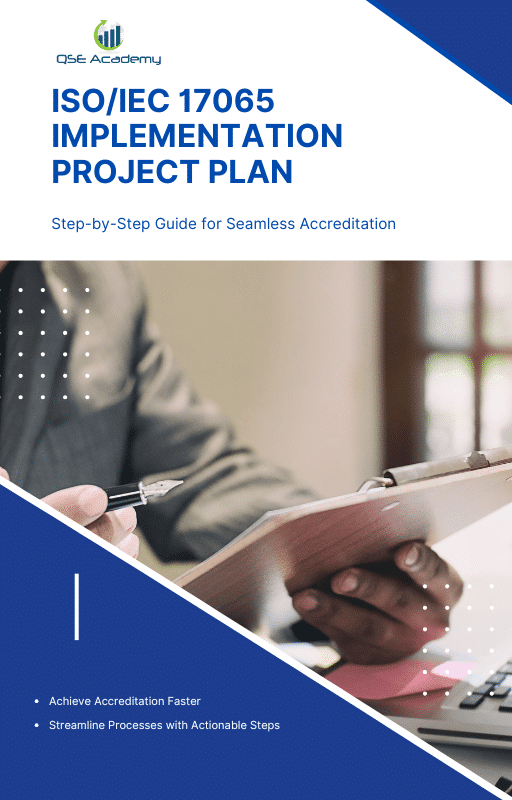Effective Techniques for Ensuring ISO/IEC 17065 Compliance
Navigating the complexities of international standards, ISO/IEC 17065 stands as a cornerstone for conformity assessment bodies. It symbolizes a badge of trust and reliability in product certification. As any organization involved in the business of certification knows, maintaining adherence to this standard is crucial.
In the ever-evolving global market, the principles outlined in ISO/IEC 17065 ensure that these bodies operate with competence and transparency, providing consumers with assurance in certified products. The following article delves into the intricacies of ISO/IEC 17065 compliance, providing readers with actionable insights for effective adherence.
Starting with a thorough understanding of the standard’s requirements and moving through meticulous preparation, procedure formulation, and diligent monitoring, this piece offers a comprehensive roadmap to ISO/IEC 17065 compliance.
Introdução
ISO/IEC 17065, titled “Requirements for bodies certifying products, processes and services,” sets the international standard for organizations that perform product certifications. With its robust framework, ISO/IEC 17065 helps ensure that certification bodies operate in a competent, consistent, and impartial manner. Compliance with ISO 17065 is imperative for certification bodies as it enhances trust and confidence among stakeholders, including regulators, manufacturers, and end consumers.
The standard evolved from ISO/IEC Guide 65 and has undergone various updates to maintain its relevance with the changing industry demands and technological advancements. It is now broadly recognized and implemented across international borders, ensuring a level playing field for all product certification bodies. Achieving compliance with ISO 17065 signifies that a certification body has met stringent requirements, encompassing the management system’s quality, staff competence, confidentiality, and independence, providing a clear benchmark for their operation and the certification schemes offered.
Scope of ISO/IEC 17065
- Certification of products, processes, and services
- Competence requirements for certification bodies
- Management of impartiality and confidentiality
- Formal certification decision processes
Compliance with ISO/IEC 17065 underpins the credibility of certification activities, enabling consumer confidence and facilitating global trade through recognized standards of product quality and safety.
Understanding ISO/IEC 17065 Requirements
ISO/IEC 17065 is the International Standard for organizations certifying products, processes, and services. Compliance with this standard assures stakeholders that the certification body has the competence and operates impartially and consistently.
Legal and Contractual Matters
Certification bodies must understand and abide by applicable laws and regulations, ensuring their operations are legally compliant. They’re required to formalize all contractual matters, laying the groundwork for clear, legal obligations between themselves and their clients.
Gestão da imparcialidade
Impartiality is pivotal. Bodies certifying products must have robust policies to manage conflicts of interest and maintain objectivity in the certification process.
Responsibility for Certification Decisions
Certification bodies hold the ultimate responsibility for their certification decisions. They must ensure those decisions are made based on objective evidence and are not influenced by external pressures.
Estrutura organizacional e gestão
An effective organizational structure is essential. Management must demonstrate a commitment to quality and impartiality, and solid frameworks must be in place for subsidiaries and contractors.
Competência do pessoal
Ensuring staff are competent and knowledgeable is a resource requirement. A clear distinction between the qualifications and experience of each member needs to be established.
General Process Overview
The general process encompasses application reviews, evaluations, surveillance, and the handling of any changes that could affect certification.
A certification body must conduct internal audits and management reviews as part of its ongoing commitment to a functional management system and continual improvement. Documentation and record-control procedures ensure traceability and accountability throughout the certification lifecycle.
Preparação e Planejamento
Before embarking on the journey towards ISO/IEC 17065 compliance, preparation and planning are critical. One of the most important preparatory steps is performing a Análise de lacunas. This process involves:
- Identifying existing practices and comparing them against the requirements set out by ISO/IEC 17065.
- Highlighting areas of non-conformance, thus detecting gaps that need addressing.
A comprehensive gap analysis enables organizations to develop an effective action plan tailored to meet the ISO standards. The action plan should be detailed and structured, specifying the necessary steps and timelines to achieve full compliance.
Securing Commitment and Leadership is also fundamental in the preparation phase. Top management must:
- Clearly define roles and responsibilities within the organization towards compliance.
- Communicate the importance of ISO/IEC 17065 to all levels of the organization to foster a culture that supports standardization.
Finalmente, Atribuição de recursos is pivotal for successful preparation. Organizations must ensure that:
- Adequate budgeting is in place for both initial implementation and ongoing compliance activities.
- Infrastructure and technology requirements are assessed and met, ensuring the necessary tools and systems are available to support conformity assessment activities.
By addressing these elements effectively, organizations lay a solid foundation for their ISO/IEC 17065 compliance efforts.
Desenvolvimento e implementação de procedimentos
Establishing Clear Policies and Procedures is of paramount importance for bodies certifying products in compliance with ISO/IEC 17065. This International Standard sets the benchmark for organizations to ensure that their certification processes are impartial and consistent across products, processes, and services. To meet these requirements, it is crucial to create and maintain comprehensive policies and documented procedures.
These guidelines should be tailored to the nature of each certification scheme and must cover every activity linked to the certification process. For robust policy development, it is fundamental that:
- Policies are clear, concise, and aligned with the principles of ISO/IEC 17065.
- Documented procedures and work instructions are established, periodically reviewed, and updated as necessary.
- Accessibility of these documents is guaranteed for all relevant personnel, ensuring that every member of the staff understands their roles and responsibilities outlined by the procedures.
The emphasis on documentation ensures that certification decisions are made using transparent methods, which can withstand scrutiny by all stakeholders, including regulatory authorities. Moreover, if non-conformities arise, documented procedures facilitate the prompt implementation of corrective actions to bring the certification processes back into compliance with the standard.
Procedures Documentation – Key Highlights
| Areas | Descrição |
| Development | Tailor policies to the certification scheme |
| Documentação | Ensure all procedures are clearly written and updated as needed |
| Accessibility | Provide staff with easy access to all relevant documents |
| Understanding | Confirm comprehension and adherence among personnel |

Ensuring Impartiality and Independence
To uphold the credibility of certification in accordance with ISO/IEC 17065, “Requirements for bodies certifying products, processes, and services,” it is crucial for a certification body to maintain impartiality and independence, especially concerning certification decisions.
Gerir os conflitos de interesses
| Potential Conflicts of Interest | Management Techniques |
| Financial interests | Establish internal policies to ensure neutrality |
| Personal relationships | Implement disclosure and recusal procedures |
| Overlapping business services | Segregate duties and responsibilities functionally |
By identifying conflicts of interest, a certification body can actively establish measures to manage and mitigate their impact. This includes maintaining transparency in the assessment process and holding accountability for decision-making to safeguard the integrity of their conformity assessment activities.
Maintaining Independence in Certification Decisions
To ensure independence in certification decisions, a certification body must:
- Establish clear and objective criteria for decision-making.
- Maintain operational separation of certification activities from other business interests.
- Regularly monitor and evaluate decision-making processes to ensure impartiality is not compromised.
By adhering to these practices, a product certification body demonstrates adherence to ISO/IEC 17065 and maintains trust with stakeholders by showing commitment to impartial and independent management system certification.
Monitoring and Continuous Improvement
To ensure compliance with ISO/IEC 17065, product certification bodies must establish robust surveillance and recertification programs. These programs are pivotal in monitoring ongoing compliance with international standards, as well as in driving continuous improvement within the certification process. Surveillance involves regular checks, while recertification audits are planned and conducted at predefined intervals. The findings from these activities provide valuable insights that can lead to the enhancement of procedures and services.
Leveraging the power of technology plays a crucial role in compliance management. Certification bodies are increasingly adopting software tools for efficient management of documentation and records. Automated systems have become essential for tracking the multitude of compliance activities, aiding in maintaining a coherent workflow and facilitating timely certification decisions. Moreover, data analytics is employed to sift through information, identifying trends that can pinpoint areas needing improvements.
Engaging stakeholders directly contributes to the culture of quality and perpetual improvement. Client involvement and other stakeholder interactions are vital components for refining certification schemes. Feedback collected becomes a cornerstone for implementing corrective actions and fostering a quality-driven ethos. By maintaining open communication channels and considering stakeholder perspectives, certification bodies can elevate their service quality and conform to the dynamic nature of regulatory and technical requirements.
| Key Concept | Techniques/Tools |
| Vigilância | Regular checks, monitoring tools |
| Recertificação | Periodic audits, recertification process |
| Technology | Compliance management software, data analytics |
| Stakeholder Engagement | Feedback mechanisms, continuous improvement meetings |
Estudos de caso e melhores práticas
Estudo de caso 1: Organismo de certificação de fabrico
A Manufacturing Certification Body seeking to comply with ISO/IEC 17065 implemented several techniques, including a robust document review system, regular internal audits, and training programs to ensure competency. They faced challenges with the complexity of technical requirements, which they addressed by hiring experts and conducting targeted training. The enhancements led to a more streamlined assessment process and improved the reliability of the certification decision, elevating their certification quality.
Estudo de caso 2: Organismo de certificação baseado em serviços
For a Service-Based Certification Body, the focus was on adhering to ISO/IEC 17065 by establishing comprehensive certification schemes and an efficient Factory Audit process. The primary challenge involved the integration of different conformity assessment combinations. The solution was to use specialized software that tracks conformity assessment activities. As a result, certification programs became more consistent, and the quality and credibility of certifications increased.
Best Practices for Ensuring Compliance
- Establishing a Strong Quality Culture: Emphasizing the importance of quality at every organizational level fosters compliance with international standards such as ISO 9001:2015.
- Leveraging Technology for Efficient Management: Using digital tools to manage compliance activities ensures accuracy and aids in tracking corrective actions and regulatory requirements.
- Engaging Stakeholders and Fostering Collaboration: Collaboration with various stakeholders ensures that competence requirements and applicable standards are well-understood and met across the board.
These practices lead to higher compliance with ISO/IEC 17065 and related conformity assessment standards like ISO/IEC 17024 and ISO/IEC 17021, ultimately ensuring quality in certifying products and management systems.
Conclusão
In summary, the journey to ISO/IEC 17065 compliance involves a dedicated approach to meeting the international standards required for bodies certifying products. A key technique includes developing and maintaining a robust management system that aligns with ISO 9001:2015 quality management principles. Furthermore, competence requirements must be rigorously upheld to facilitate sound certification decisions.
An ongoing commitment to internal audits, corrective actions, and a thorough assessment process ensures product certification bodies stay aligned with the ISO/IEC 17065 requirements. With an ever-evolving landscape, keeping abreast of regulatory requirements, technical requirements, and applicable standards is crucial for sustained compliance.
The future outlook points towards a stronger integration of various conformity assessment activities, and entities may see increased collaboration between ISO/IEC 17065, ISO/IEC 17024, and ISO/IEC 17021 to streamline the certification of products, personnel, and management systems. As a result, certification bodies will need to be agile, adapting their practices to not only meet current demands but also anticipate future trends in certification compliance.
| Key Compliance Activity | Related ISO/IEC Guide |
| Management System Implementation | ISO 9001:2015 |
| Revisão de documentos | ISO/IEC 17065 |
| Competence of Staff | ISO/IEC 17024 |
| Factory Audit | ISO/IEC 17065 |
| Decisão de certificação | ISO/IEC 17021/17065 |
Being compliant requires a structured, ongoing effort to establish and maintain adherence to the relevant standards, solidifying trust and recognition in the global market.
Referências
For those seeking a comprehensive understanding of ISO/IEC 17065 compliance, exploring core materials and additional literature is crucial. Authoritative sources provide essential guidance for product certification bodies.
Authoritative Sources on ISO 17065:
- ISO/IEC 17065:2012: The primary document outlining requirements for bodies certifying products, processes, and services.
- Guia ISO/IEC 65: The predecessor to ISO/IEC 17065, serving as a reference for historical context and the evolution of standards.
- Sítio Web ISO: Official resources, updates, and FAQs regarding ISO standards can be found here.
Normas e diretrizes relevantes do sector:
- ISO/IEC 17024: Requirements for bodies certifying persons.
- ISO/IEC 17021-1: Requirements for bodies providing audit and certification of management systems.
- ISO 9001:2015: Quality management systems – Requirements that can complement ISO/IEC 17065 regarding organizational quality.
Key literature also includes various industry journals and publications focused on conformity assessment, regulatory compliance, and quality management.
| Category | Documentação |
| Standards Compliance | ISO/IEC 17065:2012, ISO/IEC 17024, ISO/IEC 17021-1 |
| Gestão da Qualidade | ISO 9001:2015 |
| Educational & Guidance | ISO/IEC Guide 65, ISO Website resources |
Supplemental reading may involve case studies, white papers, and regulatory updates to stay abreast of best practices in certification and assessment processes.
Apêndice
To aid in achieving ISO/IEC 17065 compliance, numerous resources and tools are available. Organizations seeking certification can access templates and checklists tailored to streamline the conformance process with the international standard’s requirements. These documents are designed to ensure that product certification bodies cover all necessary bases in demonstrating their ability to competently certify products.
Additionally, there are various training and certification programs available to enhance the understanding of the ISO/IEC 17065 requirements and the skills required to effectively implement them. These educational opportunities are essential for organizations to ensure that their personnel is adequately prepared to make informed certification decisions and manage certification schemes per the relevant standard.
Essential Resources for Compliance:
- Templates: For document review, internal audit, management review.
- Checklinks: To verify fulfillment of the competence requirements, and corrective actions.
- Training Programs: Aimed at improving understanding of the ISO/IEC 17065 and related standards (e.g., ISO/IEC 17024, ISO/IEC 17021, and ISO 9001:2015).
- Certification Programs: For individuals responsible for the certification decision-making process.
Proper usage of these additional resources and tools will facilitate the effective navigation of the certification process and ensure adherence to regulatory and technical requirements.
Procurando por mais recursos sobre a ISO 17065?
Se este artigo foi útil para si, explore os nossos recursos premium concebidos para o ajudar a obter a certificação ISO 17025 de forma eficiente:
- 📦 Pacote de documentação completo para a norma ISO/IEC 17065 2012: Obtenha todos os modelos e documentos essenciais de que necessita para uma implementação rápida e fácil.
- 🎓 Curso online sobre a ISO/IEC 17065 2012 : Inscreva-se na nossa formação abrangente para dominar os conceitos-chave e os passos práticos para a certificação.
- 📋 Lista de verificação ISO/IEC 17065 2012: Descarregue a nossa lista de verificação pormenorizada para se certificar de que abrangeu todas as etapas do processo.
Estes recursos são adaptados para satisfazer as suas necessidades e garantir um percurso de certificação sem problemas. Explore-os hoje e fique um passo mais perto do sucesso!













